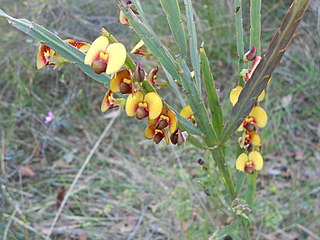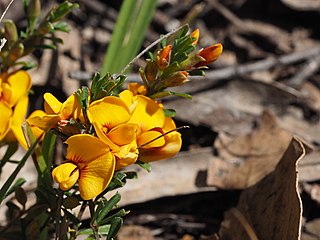
Olearia axillaris, commonly known as coastal daisy-bush, coast daisy-bush or coastal daisybush is a species of flowering plant in the family Asteraceae and is endemic to coastal areas of Australia. It is an erect, bushy shrub with densely cottony-hairy branchlets, aromatic, linear to narrowly elliptic or narrowly lance-shaped to egg-shaped leaves with the narrower end towards the base and small white and yellow, daisy-like inflorescences.

Pomaderris aspera, commonly known as hazel pomaderris, is a species of flowering plant in the family Rhamnaceae and is endemic to south-eastern Australia. It is a shrub or small tree with elliptic to lance-shaped or egg-shaped leaves and greenish-yellow flowers.

Bossiaea ensata, commonly known as sword bossiaea, is a species of flowering plant in the family Fabaceae and is endemic to south-eastern continental Australia. It is an erect or low-lying, glabrous shrub with flattened branches, flattened, winged cladodes, leaves mostly reduced to small scales, and orange-yellow and red flowers.

Leptospermum myrtifolium, commonly known as the myrtle tea-tree or grey tea-tree, is a species of shrub that is endemic to south eastern Australia. It has broad egg-shaped to elliptical leaves, white flowers usually borne singly on short side shoots, and fruit that remains on the plant until it dies.

Pultenaea aristata, commonly known as bearded bush-pea or prickly bush-pea, is a species of flowering plant in the family Fabaceae and is endemic to New South Wales. It is a small, erect shrub with linear to narrow elliptic, sharp-tipped leaves, and yellow and red flowers.

Pultenaea capitellata, commonly known as hard-head bush-pea, is a species of flowering plant in the family Fabaceae and is endemic to south-eastern continental Australia. It is a sprawling to prostrate shrub with elliptic to broadly egg-shaped leaves, and yellow to orange flowers with a red to purple keel.

Pultenaea echinula, commonly known as curved bush-pea, is a species of flowering plant in the family Fabaceae and is endemic to a small area of New South Wales. It is an erect shrub with linear, needle-shaped, grooved leaves, and dense clusters of yellow to orange and red flowers.

Pultenaea euchila, commonly known as orange pultenaea, is a species of flowering plant in the family Fabaceae and is endemic to eastern Australia. It is an erect shrub with glabrous foliage, narrow egg-shaped leaves with the narrower end towards the base, and orange-coloured flowers arranged singly or in small groups near the ends of branchlets.

Pultenaea microphylla is a species of flowering plant in the family Fabaceae and is endemic to eastern Australia. It is an erect to prostrate shrub with narrow egg-shaped leaves with the narrower end towards the base, and clusters of up to ten yellow to red flowers with reddish markings.

Bossiaea lenticularis is a species of flowering plant in the family Fabaceae and is endemic to eastern New South Wales. It is a slender, spreading shrub with mostly circular leaves, and yellow and red flowers.

Podolobium scandens, commonly known as netted shaggy-pea, is a flowering plant in the family Fabaceae and is endemic to eastern Australia. It is a prostrate, small shrub with orange-yellow pea-like flowers and red markings.

Pomaderris ligustrina, commonly known as privet pomaderris, is a species of flowering plant in the family Rhamnaceae and is endemic to south-eastern continental Australia. It is a shrub with hairy stems, lance-shaped to narrowly elliptic leaves, and loose clusters of cream-coloured or yellow flowers.
Olearia elaeophila is a species of flowering plant in the family Asteraceae and is endemic to the south-west of Western Australia. It is a small shrub with scattered linear leaves, and white or blue and yellow, daisy-like inflorescences.

Epacris coriacea is a species of flowering plant in the heath family Ericaceae and is endemic to a eastern New South Wales. It is a slender, erect shrub with hairy branchlets, egg-shaped to more or less diamond-shaped leaves and tube-shaped, white or cream-coloured flowers.

Sprengelia monticola, commonly known as rock sprengelia, is a species of flowering plant of the family Ericaceae, and is endemic to the Blue Mountains in eastern New South Wales. It is an open or low-lying shrub with egg-shaped to lance-shaped leaves, and white flowers arranged singly in leaf axils.

Olearia quercifolia, commonly known as oak-leaved olearia, is a species of flowering plant in the family Asteraceae, and is endemic to the Blue Mountains in New South Wales. It is a shrub with elliptic to egg-shaped leaves with the narrower end towards the base, and white and yellow daisy flowers.

Olearia ramosissima, commonly known as much-branched daisy bush, is a species of flowering plant in the family Asteraceae and is endemic to continental Australia. It is a straggly shrub with densely-crowded, elliptic, egg-shaped or triangular leaves, and blue to violet and blue or yellow, daisy-like inflorescences.

Pimelea floribunda is a species of flowering plant in the family Thymelaeaceae and is endemic to the south-west of Western Australia. It is a shrub with narrowly elliptic to egg-shaped leaves arranged in opposite pairs, and drooping, head-like clusters of white or cream-coloured, tube-shaped flowers.
Pimelea milliganii, commonly known as silver riceflower or Milligan's rice flower,is a species of flowering plant in the family Thymelaeaceae and is endemic to a restricted part of Tasmania. It is a low, much-branched, densely hairy shrub with more or less elliptic leaves and compact clusters of white to pinkish flowers usually surrounded by two leaf-like involucral bracts.

Billardiera variifolia is a species of flowering plant in the family Pittosporaceae and is endemic to the southwest of Western Australia. It is a twining shrub or climber with elliptic adult leaves and groups of deep purple flowers that fade to blue as they age.


















